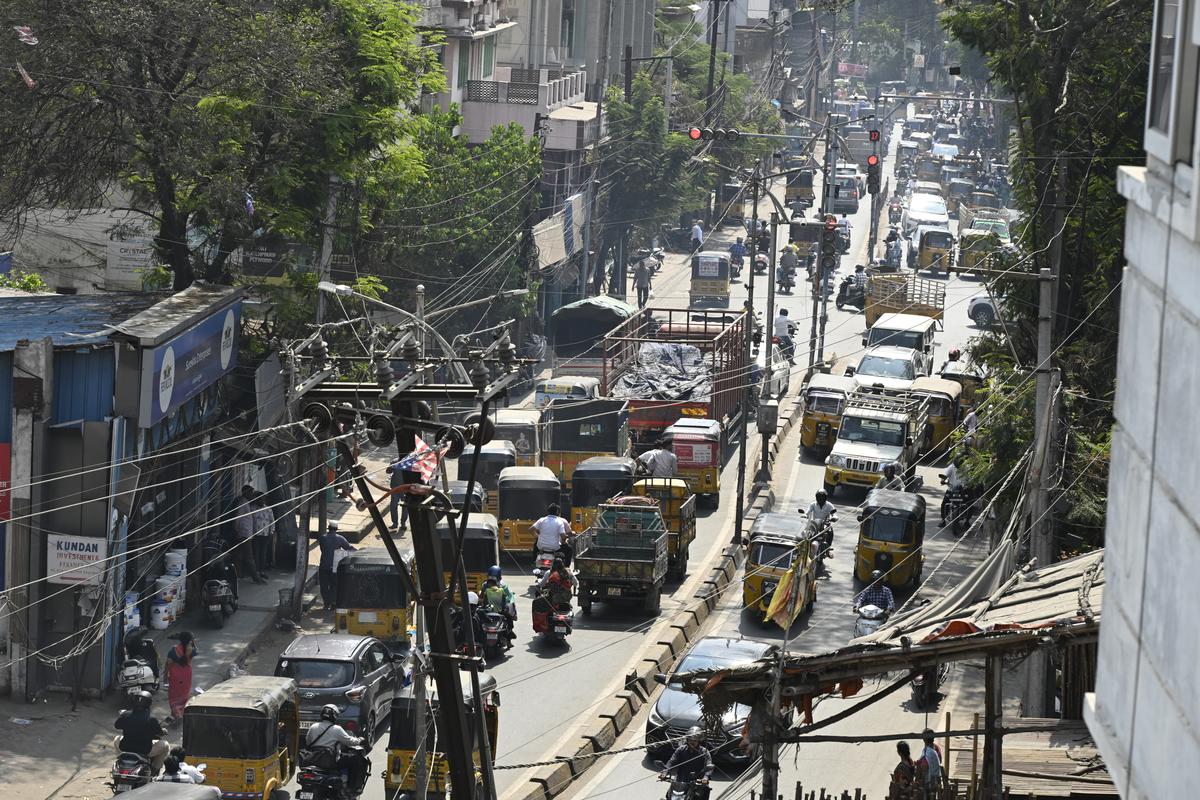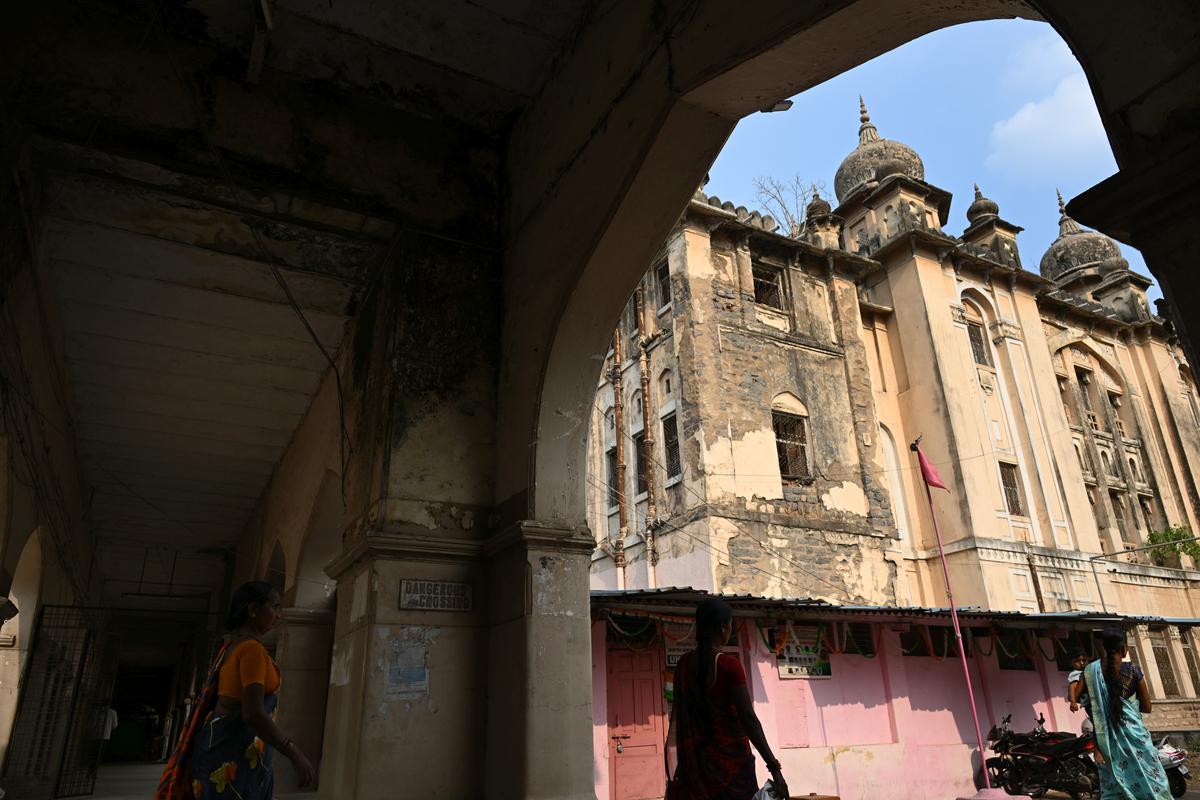As the sun dipped below the horizon, bathing the Goshamahal police grounds in a golden glow, Sunday evening settled into its usual rhythm. Far from the honking of vehicles and the hurried footsteps of pedestrians, the sprawling ground pulsed with life. Children took confident swings at makeshift wickets with their cricket bats, their laughter ringing out as tennis balls soared across the field. Above them, kites bobbed and weaved in playful duels, their strings tangling in friendly rivalry. Amid this lively scene, police personnel moved about — some on duty, others taking a leisurely stroll through the adjacent Shiv Kumar Lal Stadium after a long day at work.
It was here, just days ago, that Telangana Chief Minister A. Revanth Reddy had stood, flanked by a battalion of ministers and State government officials, laying the foundation stone for the new Osmania General Hospital (OGH) — a decision meant to mark progress, yet one that had unsettled many who had long called this place home.

At the gateless entrance of the stadium, a lone police officer stands guard. Dressed in a crisp white T-shirt and matching trousers — his physical training uniform — he keeps a watchful eye on those entering, ensuring only authorised personnel pass through. He appears to be in his late 30s, his stance firm, yet his gaze carrying something more — a quiet nostalgia.
“I grew up in the police quarters right next to this stadium,” he reveals, his voice steady but tinged with sentiment. “This ground is where I played cricket as a child, where I trained when I joined the force, and now, it’s where I serve.”
He exhales, his eyes tracing the familiar contours of the field. “Like many others, I don’t agree with the hospital coming up here instead of its old location. But there’s nothing we can do.” As he finishes his sentence, the stadium floodlights flicker on, stretching long shadows across the ground.
With the land now formally transferred to the Health department, the coming years will see a modern government hospital rise here, one that is expected to cater to the people of not just Telangana but also those from the neighbouring States of Andhra Pradesh, Karnataka, and Maharashtra.
Chaotic and congested
The chaos outside the existing OGH begins at its very gates. Autorickshaws clog the entrance, parked in a haphazard sprawl that leaves little room for vehicles to manoeuvre, whether entering the hospital or simply passing through. Security guards, tasked with managing vehicular flow, struggle against the relentless tide of congestion.
Inside the hospital, the scene is no better. Outside the Quli Qutub Shah Department of Cardiology block, a dense crowd swirls, with patients and visitors weaving in and out in an unending flow. The parking facility, located nearly 300 metres from the main gate, adds to the disorder, as vehicles honk and speed through the driveway. Even a designated walkway on the left fails to contain pedestrians, who spill onto the main road, further worsening the gridlock.
Established in 1919, the OGH is a landmark of Hyderabad, but its grandeur and importance have long been overshadowed by decades of infrastructural decay. Commissioned by the last Nizam of Hyderabad, Mir Osman Ali Khan, and designed by British architect Vincent Jerome Esch in Indo-Saracenic style, the hospital now bears the weight of neglect and lack of maintenance.
In 2010, the erstwhile united Andhra Pradesh government acknowledged its deteriorating state and proposed an ambitious plan to restore the heritage building while constructing a 12-lakh-square-foot modern facility at an estimated cost of ₹200 crore. Some old structures were to be demolished, and an international consultant was to be brought in for modern hospital design. But the plan failed to take shape.

Traffic congestion at the junction leading towards the police grounds.
| Photo Credit:
RAMAKRISHNA G.
By 2015, the Telangana government planned to shift patients to alternative facilities at Modern Government Maternity Hospital in Petlaburj and District Hospital in King Koti. Then Chief Minister K.Chandrasekhar Rao inspected the 110-year-old OGH, declaring it dilapidated and unsustainable beyond four years. In 2019, the Healthcare Reforms Doctors Association filed a public interest litigation (PIL) demanding the construction of a modern multi-storey hospital complex, complete with a nursing college and hostel.
A year later, after rainwater and sewage inundated the hospital, the Telangana government ordered its closure. By July 2023, the government submitted an affidavit to the Telangana High Court, formalising its decision to demolish OGH and replace it with a new structure. A counter-affidavit in September that year reinforced this stance, proposing an 1,812-bed modern facility.
However, the issue became politically charged ahead of the 2023 Telangana Assembly elections, when the Congress party included the preservation of OGH in its manifesto. After Congress rode to power in the State, Chief Minister Revanth Reddy announced in the State Assembly last August that the new OGH building would be constructed at Goshamahal.
Emotional attachment
Opposition to the hospital’s construction in Goshamahal is more than just mere disagreement — it is deeply tied to the lives and routines of those who have called this locality home, for generations. Residents from neighbouring areas such as Chandanwadi and Chaknawadi have expressed their concerns, fearing that the transformation of the police grounds will disrupt their way of life.
“My family has lived here for over three generations. This ground is not just an open space for us; it is where we come for walks, where our children play, and where social gatherings bring the community together. It is part of who we are,” says 32-year-old Ram Shukla, a resident of Chandanwadi.
Beyond emotional ties, there is also an underlying economic concern. The main road outside the police grounds is lined with shops selling plywood, hardware, timber, electrical goods, and sanitary supplies. For many shop owners, construction of the hospital signals an unsettling change, one that could disrupt their business patterns and threaten livelihoods. “This isn’t the right move by the government,” a merchant argues.
However, not everyone shares this view. A few shopkeepers brush off the debate, believing that the hospital’s construction is simply a part of inevitable change. They see potential in the future, hoping it will bring new opportunities rather than challenges.
A walk down the road from Goshamahal to Darussalam reveals a distinct pattern: it is a hub for construction and home improvement shops, a world far removed from anything related to healthcare. “Now, with the hospital set to come up here, everything will change,” says Ravi, 38, a businessman who runs Dhanalakshmi Timber Depot, a family establishment founded by his grandfather in 1971.
“Once the hospital opens and influx of patients begins, footfall for our businesses will drop. Eventually, we will have no choice but to shut down,” he rues.
B. Tharun, who owns a modular kitchen store just across the street, echoes Ravi’s concerns. “We have protesting from the moment we heard the government was considering Goshamahal for the new OGH. Traffic here is already a nightmare. Every year, during the 45-day All India Industrial Exhibition (Numaish), the area is clogged with vehicles. Now, the government says the hospital will see around 3,000 outpatients daily. Just imagine the kind of congestion it will then create,” he says, shaking his head in frustration.
Beyond concerns about business, residents are deeply anxious about the area’s fragile infrastructure. The road near Chaknawadi, already notorious for its history of caving in, suffered another collapse just three days before the Chief Minister laid the foundation stone for the new hospital. The hospital site is barely 500 metres from the spot.

The current Osmania General Hospital in Hyderabad.
| Photo Credit:
NAGARA GOPAL
“If the roads are already giving way under regular traffic, what will happen when ambulances race through and thousands of patients and visitors flood the area daily,” questions Ravi Singh, a longtime resident. “Will the foundations hold, or will they crumble, turning a healthcare lifeline into yet another hazard? The frequent road collapses have already become a major problem.”
Ravi also expresses concern over the proposed mortuary at the new hospital. “We have all seen the deteriorating condition of the mortuary at the current OGH. The same stench, the same infection risks… it will spread to the nearby residential areas,” he adds.
The mortuary at OGH currently operates with 40 freezers, but demand far exceeds capacity. “On average, 15 to 20 post-mortems are conducted daily, but the freezer boxes remain almost full, as unclaimed bodies must be stored for at least 72 hours,” explains a doctor from OGH’s forensic science department. With Hyderabad’s growing population and rising caseload, the doctor stresses the urgent need for greater capacity at the new hospital.
All about the new OGH
According to the Health department’s master plan, the new OGH mortuary will be larger, equipped with 100 freezers, and spanning two levels — a basement and a ground floor — designed to handle a higher volume of cases more efficiently. The new hospital will span a built-up area of 32 lakh square feet, meeting the regulatory benchmark set by the National Medical Commission (NMC) and Indian Public Health Standards (IPHS). Designed to accommodate 2,000 beds, it will aim to bolster Hyderabad’s healthcare infrastructure with 29 major and 12 minor operation theatres, each equipped with advanced surgical technology, including robotic surgery units and a dedicated transplant theatre.
The blueprint also incorporates essential modern utilities such as a sewage treatment plant, a biomedical waste management system, a high-tech laundry, and an effluent treatment plant, ensuring sustainability and efficiency in medical operations.
“The heritage structure serves little purpose for patients or doctors. This transition is something all doctors have long anticipated, a shift to a well-equipped, functional environment,” says Chandrika Reddy, a postgraduate student at Osmania Medical College (OMC) and spokesperson for the Telangana Junior Doctors Association.
Chief Minister A. Revanth Reddy arriving for the foundation stone-laying ceremony for the new building of Osmania General Hospital in Goshamahal, Hyderabad, on January 31.
| Photo Credit:
NAGARA GOPAL
She highlights another key benefit: hostel facilities within the new hospital premises. “At present, doctors working at OGH reside in OMC, which is nearly three kilometres away. This distance adds to the strain, especially for female doctors on night duty,” she adds.
According to the blueprint, the new hospital block will consist of a basement, a ground floor, and 12 upper floors, covering a total built-up area of 24.5 lakh square feet. Separate hostels for male and female students will follow the same vertical structure, with the girls’ hostel spanning 2.97 lakh square feet and the boys’ hostel occupying 1.27 lakh square feet. The faculty residence will also rise 12 floors above ground level, spread across 36,000 square feet.
The institution will further include two academic blocks — north and south — dedicated to physiotherapy, nursing and midwifery, a nursing college, a dental college, and an auditorium. Each block will consist of a basement, a ground floor, and nine upper floors, with a built-up area of 88,000 square feet per block. The total cost of construction is estimated at ₹2,700 crore, with the hospital slated for completion in two years, the Health Minister has said.
OGH currently operates with 1,168 beds and sees 1,500 to 2,000 outpatient visits daily. “With the new facility, we are set to elevate healthcare services, not just for Telangana but also for patients from neighbouring States like Karnataka, Maharashtra, and Andhra Pradesh, who have trusted OGH for decades,” says hospital superintendent Rakesh Sahay.
Published – February 07, 2025 10:44 am IST




